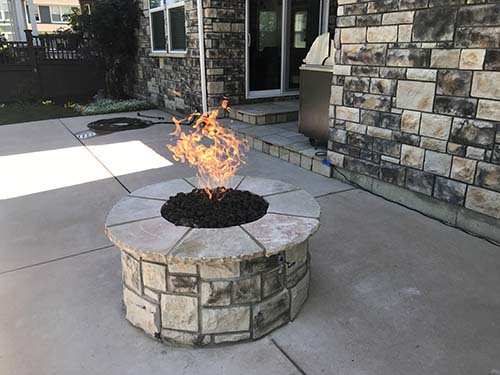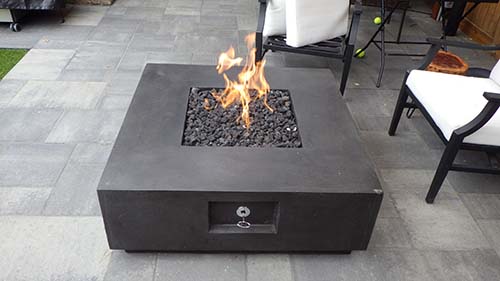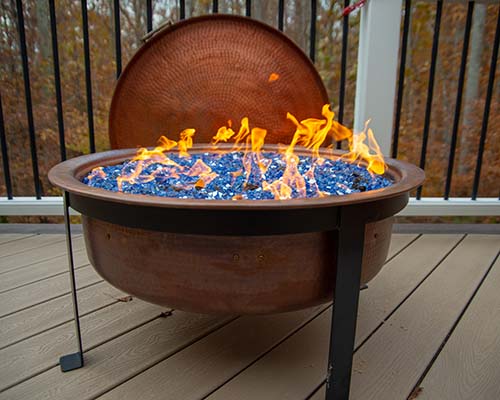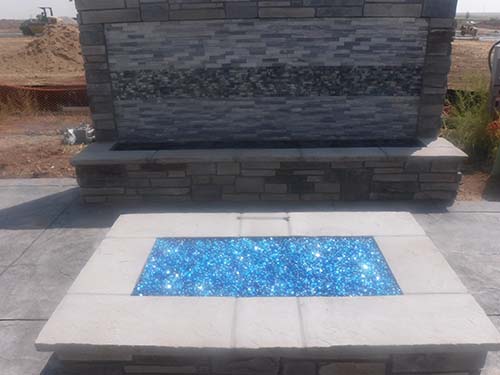Having a gas fire pit installation is a decision you won’t regret. These stunning appliances are not only easy to maintain but will also add to the ambiance of your outdoor gathering space. Whatever look you’re going for, there’s a gas fire pit for you!
There are countless reasons to install a gas fire pit. Seven of our favorites are:
- They’re fast and easy to light.
- Once lit, these units will provide constant heat without the need to continuously feed the fire. This easy access to heat will extend your outdoor living season by months!
- You have complete control of the flame at all times.
- Natural gas is clean burning which saves the environment and saves you time.
- There’s no need to clean up that grimy ash when you’re done enjoying the fire.
- Around a gas fire pit is the perfect place for friends and family to gather. The time spent there will bring you closer, and no one will turn down free s’mores!
- They’re completely customizable. Pick from a variety of pre- designed options or create one from scratch.
Invest the time now to get a fire pit so you can reap these benefits and more for years to come.
If you’re interested in installing a gas fire pit at your home, contact us for a free estimate at 303-466-4206 or info@thegasconnection.com.
Want even more information about gas fire pits? Read below for more information on:
- Types of Gas Fire Pits
- Gas Fire Pit Components
- Gas Pipe Installation
- Meeting Code Requirements
- Gas Fire Pit Operation

Installing a Gas Fire Pit | Advantages of Each Type
Custom
Custom gas fire pits provide an opportunity to design your own outdoor centerpiece! Your choice in shape, stone, and accessories are all within reach, and the combinations are endless. Although they are a little more expensive, they are built to withstand the elements so you will be enjoying the quality of this product for years to come.
Due to the customization, this type of gas fire pit installation will also take slightly longer to build and install, but the memories that will be made around it will far outweigh the time needed to truly make it your own.
Pre-fab Gas Fire Pits
Prefabricated gas fire pits provide absolute convenience. If there are worries about weight, space or time, this is a perfect option. Although they don’t last as long as custom built fire pits, that isn’t to say that they aren’t high quality.
Quality pre-fabs can be ordered online or purchased in a local home improvement/ fireplace store. Even though there isn’t the option for complete customization, there are countless options to choose from, so one is sure to fit your needs. Once the fire pit arrives, all that’s left to do is connect it to the gas line before and you have a radiant addition to your outdoor room.
Installing a Gas Fire Pit | What’s needed?
The following components of a natural gas fire pit will come built into the pre-fabricated option, but are open for personalization if you opt for a custom fire pit. Either way, it is important to be educated on what makes up your fire pit.
Gas Line
Gas lines make it possible to transfer natural gas from the home’s main source of gas to the appliances. At The Gas Connection, we use polyethylene combined with approved fittings – the same gas lines that are used by your local utility company.
Only polyethylene and approved coded underground gas pipe should be used. If the correct type of pipe is installed properly, you should never have to replace your gas line. With that being said, avoid copper, black iron, and galvanized pipe at all costs.
Gas Burner
Most gas burners are made of stainless steel because they are heat and rust- resistant metal. This is the component of the fire pit that distributes the natural gas. It comes in many shape options, and each with holes in it, allowing the natural gas to disperse and produce the desired flame.
Air Hole Drainage
This is an often overlooked component that has many benefits. Primarily, it helps keep the inside of the fire pit cooler which will lead to more efficient operation and help the unit last longer.
The fire pit will have a prolonged life since there is less heat transfer damaging the burner and key valve. Secondly, it will allow for drainage of excess water after a rain or snow storm. Lastly, it will enable the flames to go higher than they could without the air holes.
Key Valve
This piece of the gas fire pit is extremely important. It connects the gas line to the burner, is located on the side of the fire pit and controls the flow of gas. When it is turned on it allows gas to flow into the burner andstops the flow of gas when it’s off. Because it adjusts the gas flow, that means it also controls the flame height.

Heat Shield
Heat shields are placed beneath the burner to reflect heat upwards rather than leaving it to linger within the pit. This will help keep your appliance in good condition as heat transfer won’t damage the inner piping. The heat shield also supports the lava rock.
Lava Rock
Lava rock is for both appearance and function. It covers all of the inner piping and make it aesthetically pleasing. It is also a very safe media to use. For example, rocks such as sandstone, river rock, and gravel, will often crack or even explode under high heat. Lava rock, however, will do neither of those things under heat which is why it is the perfect constituent of the fire pit.
Gas Fire Pit Installation | Sizing

Sizing
Sizing is calculated from the meter to the furthest distance which, in this case, would be your fire pit. Once the BTU demand is determined (which is how much gas your fire pit will use every hour), there is a formula that will calculate what size the gas line needs to be.
This sizing formula is dictated by sizing charts in the International Fuel Gas Code. Pay special attention to the inlet pressure needed for the chosen fire pit, as this will affect the requirements for the pipe sizing.
Pressure
The gas pressure for your newly installed fire pit is critical to maintaining the proper fuel to air ratio needed for optimal operation. What your utility company is providing for your home will be your starting point.
Verifying the pressure they are delivering and the pressure they are capable of providing will allow you to properly size the gas line and provide the most realistic burning gas fire pit.
Knowing these variables will give a certified gas installer the needed information to make your new gas fire pit the envy of your neighborhood.
Meeting Code Requirements | Process
- A gas line from the meter to the fire pit requires a permit through your local jurisdiction by a contractor.
- The contractor will then install the gas line and perform an air test of minimum 40x the working pressure, to ensure the safety of the gas line.
- A city inspector will then come to inspect the pressure, depth and material of the gas line and other applicable codes.
Gas Fire Pit Installation | Operation
There are a few tips to maximize the enjoyment of your gas fireplace once installation is complete. Depending on what fire pit you’ve decided on, one of the three ways below will help you start it up.
When you first open the gas valve, do not turn the gas all the way up! Start with a smaller amount of gas flow and, once the flames are burning, you can adjust the gas. If you want larger flames, turn the valve to allow more gas flow and if you want smaller flames, minimize the flow of gas.
Match Lit
This is the most basic and reliable way to ignite your fire. Begin by using your gas valve key to open the valve and allow gas to start flowing. Once that step is complete, take a long-stem lighter, or something similar, and get close to the burner.
With the lighter close to the burner, the gas will ignite. Once your wonderful campfire experience needs to come to an end, simply turn the gas valve to the right, and that will extinguish the flame.

Piezo Igniter or “Spark ignition”
This fire pit is installed with an igniter probe to make the process of starting the fire easier than before. Although this ignition system is convenient, it is not as reliable when compared to the match lit process.
The first step is the same as the match lit unit – turn the gas valve key to allow gas to flow. After that, push the button that is located next to the gas valve key until the gas has ignited. At this point the flames should be going and when you’re done relaxing around the fire, simply close the gas valve.
Electronic Ignition
Electronic Ignition is the third and final option. A fire pit that has been installed with an electronic ignition system is by far the simplest to operate. It runs on sophisticated electronics, but what you need to know is very straightforward. Depending on your appliance, flip a switch or press the “on” button on your remote and your fire pit now has gas flowing and flames burning.
Although this is a wonderful way to start your fire pit, it is the least reliable. Any time electronics are exposed to the elements there will be service calls. Your lifestyle and anticipated use of your fire pit should help you in making the decision of which option you want.
Request Your FREE Consultation Today!
Fill in your information below to get in touch with The Gas Connection. We typically respond to most inquiries on the same day. Additionally, you can call us at 303-466-4206